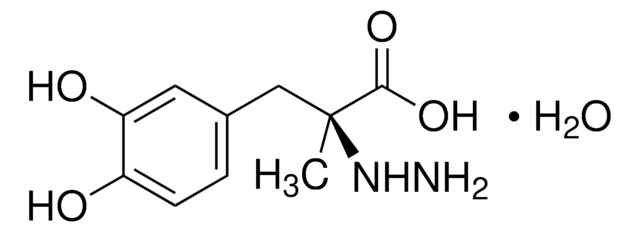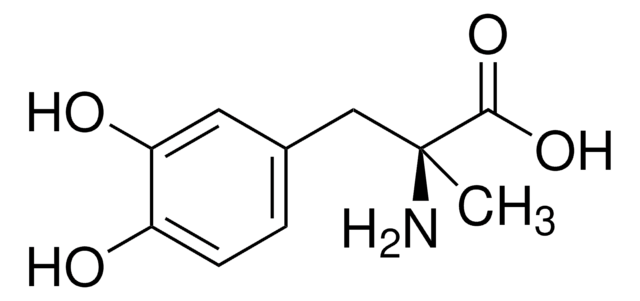おすすめの製品
グレード
pharmaceutical primary standard
APIファミリー
levodopa
メーカー/製品名
USP
mp
276-278 °C (lit.)
アプリケーション
pharmaceutical (small molecule)
フォーマット
neat
保管温度
2-8°C
SMILES記法
N[C@@H](Cc1ccc(O)c(O)c1)C(O)=O
InChI
1S/C9H11NO4/c10-6(9(13)14)3-5-1-2-7(11)8(12)4-5/h1-2,4,6,11-12H,3,10H2,(H,13,14)/t6-/m0/s1
InChI Key
WTDRDQBEARUVNC-LURJTMIESA-N
遺伝子情報
human ... DRD3(1814)
類似した製品をお探しですか? 訪問 製品比較ガイド
詳細
この製品は薬局方標準品です。発行元の薬局方により製造・供給されています。MSDSを含む製品情報などの詳しい情報は、発行元の薬局方のウェブサイトよりご確認ください。
アプリケーション
Levodopa USP reference standard, intended for use in specified quality tests and assays as specified in the USP compendia. Also, for use with USP monographs such as:
- Carbidopa and Levodopa Tablets
- Carbidopa and Levodopa Orally Disintegrating Tablets
- Carbidopa and Levodopa Extended-Release Tablets
アナリシスノート
These products are for test and assay use only. They are not meant for administration to humans or animals and cannot be used to diagnose, treat, or cure diseases of any kind.
その他情報
Sales restrictions may apply.
関連製品
製品番号
詳細
価格
シグナルワード
Warning
危険有害性情報
危険有害性の分類
Acute Tox. 4 Oral - Eye Irrit. 2 - Skin Irrit. 2 - STOT SE 3
ターゲットの組織
Respiratory system
保管分類コード
11 - Combustible Solids
WGK
WGK 3
引火点(°F)
Not applicable
引火点(℃)
Not applicable
適用法令
試験研究用途を考慮した関連法令を主に挙げております。化学物質以外については、一部の情報のみ提供しています。 製品を安全かつ合法的に使用することは、使用者の義務です。最新情報により修正される場合があります。WEBの反映には時間を要することがあるため、適宜SDSをご参照ください。
Jan Code
1361009-200MG:
試験成績書(COA)
製品のロット番号・バッチ番号を入力して、試験成績書(COA) を検索できます。ロット番号・バッチ番号は、製品ラベルに「Lot」または「Batch」に続いて記載されています。
この製品を見ている人はこちらもチェック
Damian M Herz et al.
Annals of neurology, 75(6), 829-836 (2014-06-04)
In Parkinson disease (PD), long-term treatment with the dopamine precursor levodopa gradually induces involuntary "dyskinesia" movements. The neural mechanisms underlying the emergence of levodopa-induced dyskinesias in vivo are still poorly understood. Here, we applied functional magnetic resonance imaging (fMRI) to
PvdP is a tyrosinase that drives maturation of the pyoverdine chromophore in Pseudomonas aeruginosa.
Pol Nadal-Jimenez et al.
Journal of bacteriology, 196(14), 2681-2690 (2014-05-13)
The iron binding siderophore pyoverdine constitutes a major adaptive factor contributing to both virulence and survival in fluorescent pseudomonads. For decades, pyoverdine production has allowed the identification and classification of fluorescent and nonfluorescent pseudomonads. Here, we demonstrate that PvdP, a
Nicolas Morin et al.
Experimental neurology, 256, 105-116 (2013-01-31)
The treatment of motor symptoms of Parkinson disease (PD) with the dopamine (DA) precursor, l-3,4-dihydroxyphenylalanine (l-DOPA) introduced 50years ago still remains a very effective medication. However, involuntary movements termed l-DOPA-induced dyskinesias (LID) appear in the vast majority of PD patients
Lukas L Imbach et al.
Parkinsonism & related disorders, 20(11), 1283-1286 (2014-09-28)
Diagnosis and treatment of tremor are largely based on clinical assessment. Whereas in some patients tremor may respond to dopaminergic treatment, in general l-Dopa response to tremor varies considerably. The aim of this study was to predict l-Dopa response by
Vincent J J Odekerken et al.
Neurology, 84(13), 1355-1361 (2015-03-01)
To assess the neuropsychological outcome 12 months after bilateral deep brain stimulation (DBS) of the globus pallidus pars interna (GPi) or subthalamic nucleus (STN) for advanced Parkinson disease. We randomly assigned patients to receive either GPi DBS or STN DBS.
ライフサイエンス、有機合成、材料科学、クロマトグラフィー、分析など、あらゆる分野の研究に経験のあるメンバーがおります。.
製品に関するお問い合わせはこちら(テクニカルサービス)







